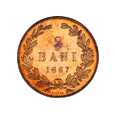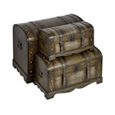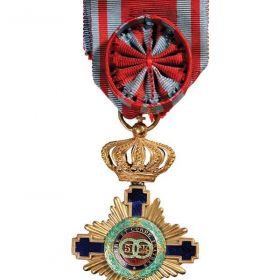The Order of the Union
Text & photo: Martin Tudor
From his first years of rule, prince Alexandru Ioan Cuza attempted to obtain from the Ottoman Empire the right to award decorations. Trying to devise a strategy meant to gradually lead to the attainment of the country’s full autonomy, prince Cuza considered there existed no treaty containing the express interdiction to establish a system of rewards and he generally relied on the tactic of facing the suzerain power with a fait accompli.
Alexandru Ioan Cuza had planned to establish a Romanian National Order based on the model of the French Legion of Honor since 1859. Taking advantage of his good relations at the French Royal Court, the Romanian Minister in France, Vasile Alecsandri, requested Emperor Napoleon III the permission for French officials to be awarded and be able to wear the future Romanian Order. The proposal was accepted by the Emperor, who did not realize then that according to provisions of international law, the Romanian principalities could not establish a system of decorations, on account of them being under Ottoman suzerainty. Back home, Alecsandri, suggested the establishment of the “Order of the Golden Garland”, which was supposed to be awarded to both Romanians and foreigners who had served the United Principalities. The order was to have both a civilian and a military component.
Obverse: the following motto “ONORE PATRIA” was supposed to be inscribed. Reverse: the legend “IN UNA OMNIA”. Sash: it was supposed to be made out of blue moiré bordered with yellow.
The Central commission changed the name of the Order into “The Order of the Cross of the Union,” in short “The Order of the Union”. It was to be divided into five grades, consisting of 1000 members (750 knights, 60 commanders, 28 Grand Officers and 12 Grand Crosses). The last two also had a plaque, worn on the right side of the chest.
Having met with a fierce opposition from both the Ottoman and the Austrian Empires – that considered this endeavor a clear sign of asserting the country’s sovereignty - and in order not to jeopardize Cuza’s double election – the project was not realized then, being postponed. A first depiction of the order can be observed in the draft coat of arms drawn by painter Carol Popp de Szathmary in 1863.
In 1864, the prince asked the Romanian representative in Paris, Vasile Alecsandri, to contact a renowned jewelry house, in order to create the decoration. The Parisian Kretly House proposed a model that was immediately accepted by the prince, and later, based on his agreement, an order for 1000 copies was placed. The model created by the Kretly House consisted of a crosslet cross enameled with blue, a shape scarcely used at that time.
Obverse: the numbers 5 and 24, placed between two laurel wreaths – the dates of Alexandru Ioan Cuza’s double election as prince of the United Principalities, and on the margins the motto “GENERE ET CORDE FRATRES” ("BROTHERS THROUGH ORIGINS AND FEELINGS").
Reverse: the cipher of the prince in ligature “AI 1”
Sash: blue moiré bordered by the three colours of the national flag.
The decoration was to have three grades – Knight, Office, Commander.
Also, it appears the order was also produced in Romania by two engraving houses: the Resch House and the Fain House. Unable to establish and award the Order due to the country’s status as vassal of the Ottoman Empire, Cuza awarded it, on his own account, to only a few acquaintances.
This order was used as model for the first official distinction awarded by the Romanian state, The National Order of the Star of Romania, established on May the 10th 1877. This order is among the few distinctions (together with The Cross "The Sanitary Merit", The Order "The Cultural Merit" and The Order "The Agricultural Merit.) which were found, under different forms, in the Romanian system of decorations after 1948 and 1989.
NHMR owns: The Order of the Union, second model, which belonged to painter Carol Popp de Szathmari.















